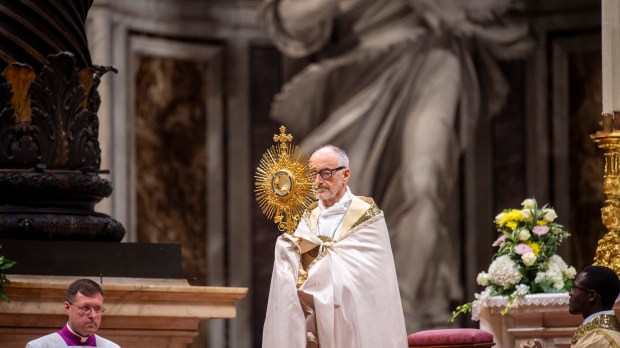Pope Francis is urging shrines and pilgrimage sites to make sure that they are, above all, places of prayer, where people can be reconciled to God through the Sacrament of Confession.
Pope Francis met with a group of shrine rectors and workers at the Vatican on November 11. They were gathered for their Second International Meeting, an initiative promoted by Archbishop Rino Fisichella and organized by the Dicastery for Evangelization.
Pilgrims go to shrines, “above all, to pray,” the Pope emphasized, saying that people who are in charge of shrines need to “remain ever mindful that our Shrines are truly privileged places of prayer.”
He praised the effort and care that goes into the celebration of the Eucharist and Confession. And regarding Confession, he urged that priests be carefully selected, “so that it does not happen that those who come to the confessional attracted by the Father’s mercy encounter obstacles to experiencing true and full reconciliation.”
The Sacrament of Reconciliation is to forgive, always. To forgive. It cannot happen, especially in shrines, that they find obstacles; no, it cannot happen, because in [the priests] God’s mercy demands to be expressed in a superabundant way, by their very nature. This is how the faithful rightly perceive them: as special places in which to encounter God’s grace. Always forgive as the Father forgives. Forgive.
The Pope said that at shrines, we can “touch directly the faith of our faithful people, which must be kept alive and nurtured with prayer, primarily the Rosary, which helps to pray through meditation on the mysteries of the life of Jesus and the Virgin Mary.”
The Rosary is a “sweet commitment that brings the flavor of the Gospel to everyday life.”
Adoration and silence in our churches
As well, the Pope urged that “particular attention” be given to adoration.
We have lost something of the sense of adoration. We must regain it. Perhaps we need to realize that the ambience and atmosphere of our churches do not always invite people to gather and worship. We must encourage pilgrims to experience contemplative silence – and it is not easy – adoring silence. This means helping them to fix their gaze on the essentials of faith.
The Pope has lately been often repeating this call to Eucharistic Adoration.
Adoration is not a departure from life; rather it is the space to give meaning to everything, to receive the gift of God’s love and to be able to bear witness to it in fraternal charity. And we can ask the question: “What about me, am I used to the prayer of adoration?” It is important to answer.
Consolation in the many difficulties of life
The Holy Father noted that pilgrims go to shrines to be consoled, as they “bear in the spirit and the body a weight, a suffering, a worry! The sickness of a loved one, the loss of a family member; so many situations in life are often the cause of loneliness and sadness, which are laid on the altar and await a response.”
The mystery of consolation. […] Consolation is not an abstract idea, and is not made up first and foremost of words, but of a compassionate and tender closeness that understands pain and suffering. Compassionate and tender closeness. This is God’s style: close, compassionate and tender. This is the way of the Lord. To console is to make God’s mercy tangible; that is why the service of consolation cannot be missing from our Shrines.
Those who care for the Shrine must make the Apostle’s words their own: He comforts us in all our affliction, so that we may be able to comfort those who are in any affliction, with the comfort with which we ourselves are comforted” (2 Cor 1:4). One, two, three, four, five times – in two lines – the word comfort, to comfort; it is dense in Paul’s text.
I can be an effective sign of comfort to the extent that I have personally experienced being comforted by the salvific suffering of Jesus and have found refuge in Him. Do not forget. In our history, each one of us has difficult, ugly moments in which the Lord has comforted us. Do not forget this. And remembering our own experience of consolation will help us to console others. And this experience passes through the motherhood of Mary, the “Consolata” par excellence. May consolation and mercy abound in our Shrines!
To be filled with hope
Lastly, the Pope noted how pilgrims “need hope.” They go to shrines “to look to the future with greater confidence.”
So, it is important that, returning home, they feel this has been fulfilled, and are filled with serenity because they have placed their trust in God. In our shrines, great care is taken to welcome – please do not forget this: welcome pilgrims well – and rightly so. At the same time, just as much pastoral care must be given to the moment when pilgrims leave the shrine to return to their ordinary lives: that they receive words and signs of hope, so that the pilgrimage they have made achieves its full meaning.
A year on the centrality of prayer
The Pope went on to say that 2024 will be dedicated to prayer and that guides will be published “to help rediscover the centrality of prayer.”
Let us renew every day the joy and commitment to being men and women of prayer. Prayer that comes from the heart, not like parrots. No. From the heart. May the words that are spoken come from the heart.
See Aleteia’s Travel section to consider options for pilgrimage sites.


